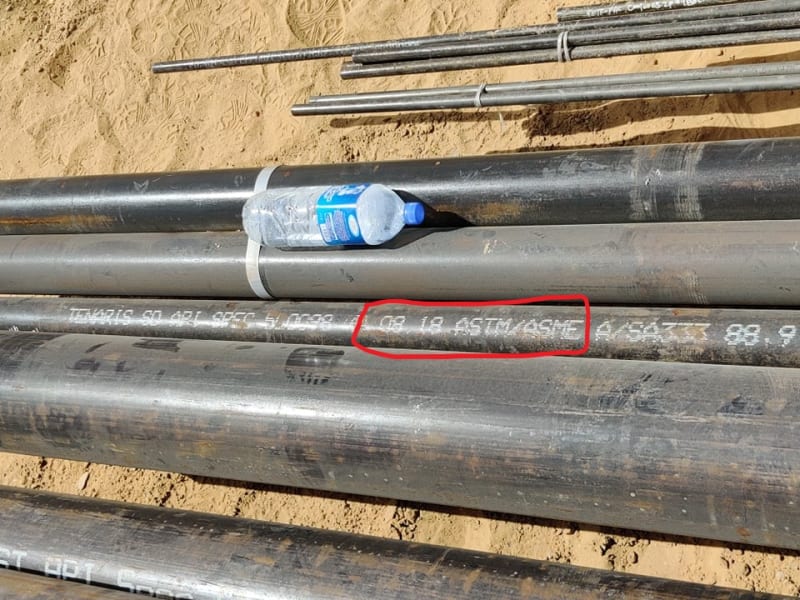Navigation
Install the app
How to install the app on iOS
Follow along with the video below to see how to install our site as a web app on your home screen.
Note: This feature may not be available in some browsers.
More options
Style variation
-
Congratulations cowski on being selected by the Eng-Tips community for having the most helpful posts in the forums last week. Way to Go!
You are using an out of date browser. It may not display this or other websites correctly.
You should upgrade or use an alternative browser.
You should upgrade or use an alternative browser.
corrosion of pipes
- Thread starter siridi
- Start date
- Status
- Not open for further replies.
LittleInch
Petroleum
Lots and lots of methods of testing. So much depends on data you haven't told us (i.e. ANYTHING useful)
You do a fitness for purpose assessment or, I would suggest, get someone else to do it who knows what they are doing.
If you want some reading try ASME FFF-1 or ASME B31G.
This is the intro to FFS-1
Fitness-For-Service ( FFS ) assessments are quantitative engineering evaluations that are performed to
demonstrate the structural integrity of an in-service component that may contain a flaw or damage, or that may
be operating under a specific condition that might cause a failure. This Standard provides guidance for
conducting FFS assessments using methodologies specifically prepared for pressurized equipment. The
guidelines provided in this Standard can be used to make run-repair-replace decisions to help determine if
components in pressurized equipment containing flaws that have been identified by inspection can continue to
operate safely for some period of time. These FFS assessments are currently recognized and referenced by
the API Codes and Standards (510, 570, & 653), and by NB-23 as suitable means for evaluating the structural
integrity of pressure vessels, piping systems and storage tanks where inspection has revealed degradation
and flaws in the equipment.
Remember - More details = better answers
Also: If you get a response it's polite to respond to it.
You do a fitness for purpose assessment or, I would suggest, get someone else to do it who knows what they are doing.
If you want some reading try ASME FFF-1 or ASME B31G.
This is the intro to FFS-1
Fitness-For-Service ( FFS ) assessments are quantitative engineering evaluations that are performed to
demonstrate the structural integrity of an in-service component that may contain a flaw or damage, or that may
be operating under a specific condition that might cause a failure. This Standard provides guidance for
conducting FFS assessments using methodologies specifically prepared for pressurized equipment. The
guidelines provided in this Standard can be used to make run-repair-replace decisions to help determine if
components in pressurized equipment containing flaws that have been identified by inspection can continue to
operate safely for some period of time. These FFS assessments are currently recognized and referenced by
the API Codes and Standards (510, 570, & 653), and by NB-23 as suitable means for evaluating the structural
integrity of pressure vessels, piping systems and storage tanks where inspection has revealed degradation
and flaws in the equipment.
Remember - More details = better answers
Also: If you get a response it's polite to respond to it.
- Thread starter
- #3
hi
thank you for the help and for more details we have an older pipes in our factory we need to exploit it witch is important to know the date of manufacturing from the marking in pipe but we dont have the MTC for this quantity so my questions are
-where we can find the date of fabrication from the pipes marking ( is it written on pipe ?)
- only the measuring of thickness is useful or is there more test like ultrasonic if yes it s shall be done or not ) and finally refers photos in attachment ,
Regards
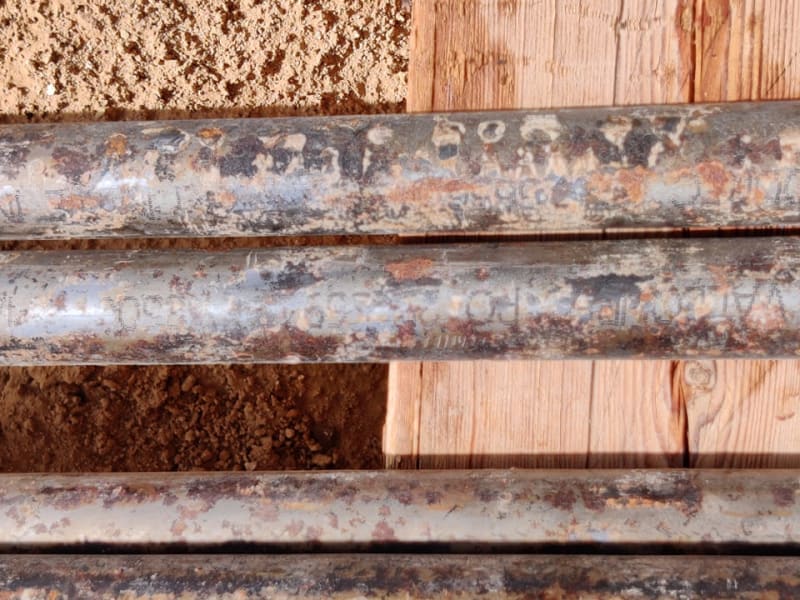
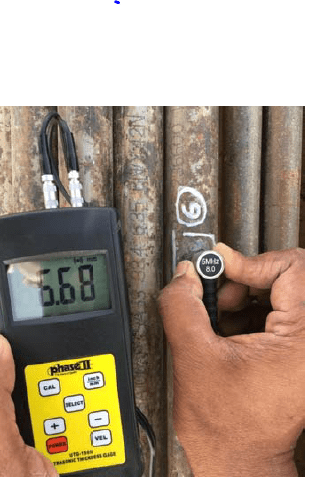
thank you for the help and for more details we have an older pipes in our factory we need to exploit it witch is important to know the date of manufacturing from the marking in pipe but we dont have the MTC for this quantity so my questions are
-where we can find the date of fabrication from the pipes marking ( is it written on pipe ?)
- only the measuring of thickness is useful or is there more test like ultrasonic if yes it s shall be done or not ) and finally refers photos in attachment ,
Regards


LittleInch
Petroleum
You can't find date of manufacture from anything other than the records of manufacture / data books.
A particular vendor may have a certain code, but it is vendor specific. Why are you interested? 50 year old pipes in good condition are better than 5 year old pipes with corrosion
UT thicknesses is good but is only spot location. But if the pits are not too deep then that can be used.
If the corrosion is only superficial (<1mm) then just clean them off with a blasting machine.
Deeper pits you need to assess.
Remember - More details = better answers
Also: If you get a response it's polite to respond to it.
A particular vendor may have a certain code, but it is vendor specific. Why are you interested? 50 year old pipes in good condition are better than 5 year old pipes with corrosion
UT thicknesses is good but is only spot location. But if the pits are not too deep then that can be used.
If the corrosion is only superficial (<1mm) then just clean them off with a blasting machine.
Deeper pits you need to assess.
Remember - More details = better answers
Also: If you get a response it's polite to respond to it.
If you can find the heat number and the manufacturer, you can find when it was produced by the manufacturer. While you want to use the as yet unidentified pipe materials for some manufactured item, it depends on the item's end use and purchaser. It may well have to be scrapped or downgraded to something like fence posts or other use not requiring traceability to a required specification. This may be the price your company must pay for not properly warehousing its materials.
You can easily determine thickness and mechanical properties of the existing pipe by simple measurements and tensile testing of each piece if necessary.
You can easily determine thickness and mechanical properties of the existing pipe by simple measurements and tensile testing of each piece if necessary.
LittleInch
Petroleum
I can just about make out a Purchase order number (PO xxxx) Surely you must have PO record numbers??
Remember - More details = better answers
Also: If you get a response it's polite to respond to it.
Remember - More details = better answers
Also: If you get a response it's polite to respond to it.
You might be permitted in some cases to use/reuse old pipe without original yield strength documentation, if you downgrade to 18,000 psi yield strength and calculate your allowable pressure accordingly (and if there is corrosion, by using B31G or similar methods as LittleInch mentioned). You might also be able to re-establish an allowable yield stress by doing specific numbers of tensile tests on specimens pulled from your pipes. SEE YOUR DESIGN CODE for what you are allowed to do with undocumented pipe.
“What I told you was true ... from a certain point of view.” - Obi-Wan Kenobi, "Return of the Jedi"
“What I told you was true ... from a certain point of view.” - Obi-Wan Kenobi, "Return of the Jedi"
- Thread starter
- #9
hi everyone
I appreciate all your responses and for go more deeply in the subject i will attached more photos showing a different markings in the pipe so my question is
to know if the different marking highlighted in the attached pipe pictures is related to the fabrication date of the pipes or the ASTM revision date.
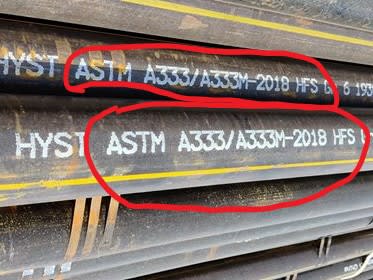
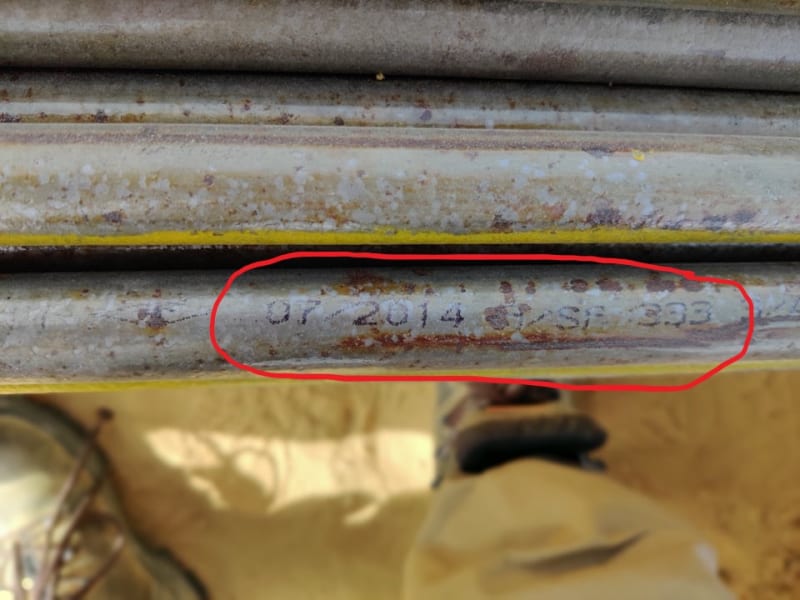
I appreciate all your responses and for go more deeply in the subject i will attached more photos showing a different markings in the pipe so my question is
to know if the different marking highlighted in the attached pipe pictures is related to the fabrication date of the pipes or the ASTM revision date.


- Thread starter
- #10
- Status
- Not open for further replies.
Similar threads
- Question
- Replies
- 2
- Views
- 615
- Locked
- Question
- Replies
- 7
- Views
- 3K
- Question
- Replies
- 9
- Views
- 3K
- Locked
- Question
- Replies
- 4
- Views
- 2K
- Locked
- Question
- Replies
- 10
- Views
- 1K

